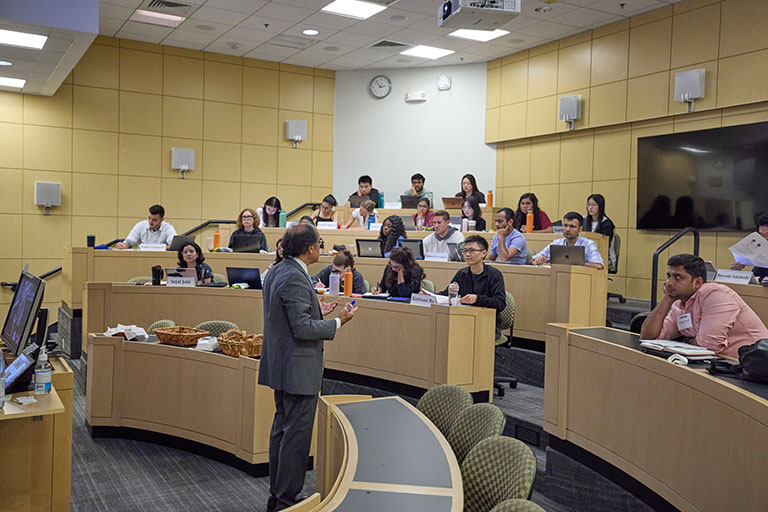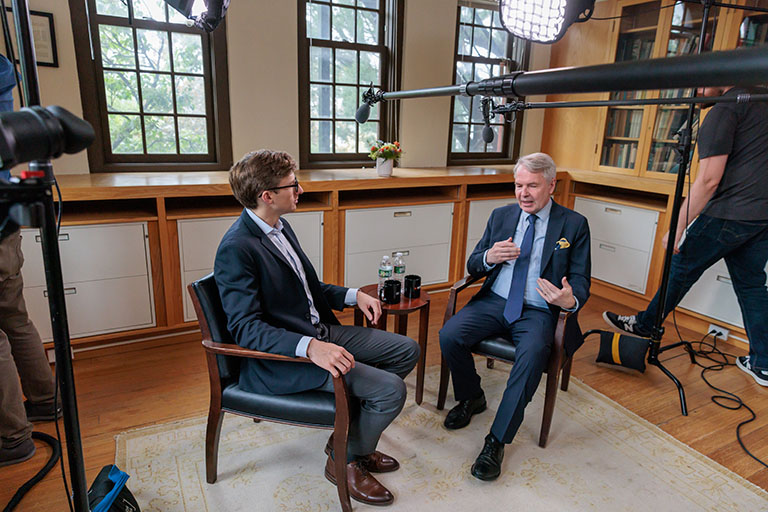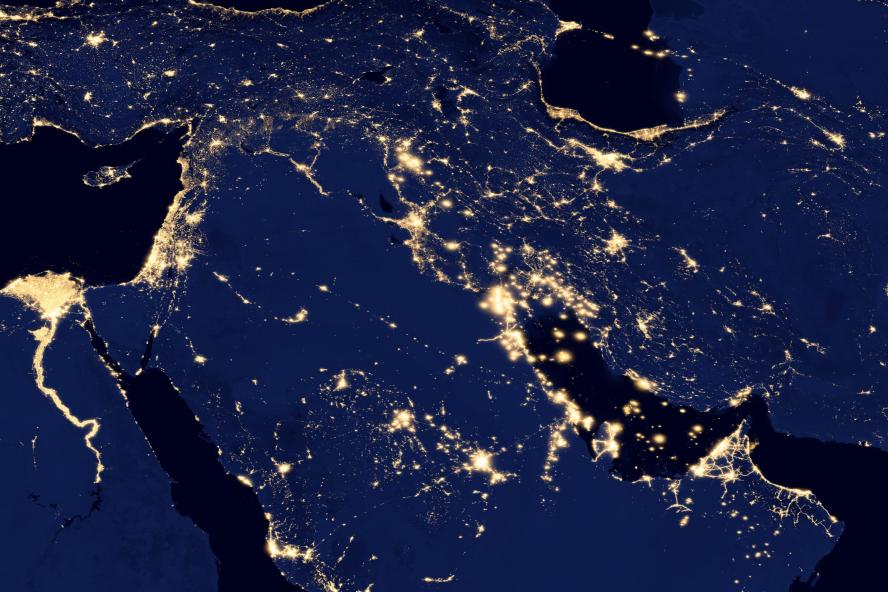-

Hear from Professor Monica Toft
Learn how Professor Monica Toft is shaping the study of global affairs and diplomacy at Fletcher.
Hear from Prof. Toft -

Explore Fletcher academics in action
Fletcher Features offers insights, innovation, stories and expertise by scholars.
Get global insights -
Get application tips right from the source
Learn tips, tricks, and behind-the-scenes insights on applying to Fletcher from our admissions counselors.
Hear from Admissions -

Research that the world is talking about
Stay up to date on the latest research, innovation, and thought leadership from our newsroom.
Stay informed -
Meet Fletcherites and their stories
Get to know our vibrant community through news stories highlighting faculty, students, and alumni.
Meet Fletcherites -

Forge your future after Fletcher
Watch to see how Fletcher prepares global thinkers for success across industries.
See the impact -

Global insights and expertise, on demand.
Need a global affairs expert for a timely and insightful take? Fletcher faculty are available for media inquiries.
Get in Touch
Understanding a Crisis: Iran, Israel and the United States
Fletcher experts offer insights on current events in the Middle East

The dramatic escalation of tensions between Iran, Israel and the United States in 2025 has captured global headlines. These developments raise urgent questions about U.S. foreign policy, nuclear diplomacy and the role of international law.
This page features timely analysis from leading experts at The Fletcher School on the latest developments, implications for global security and potential paths forward for diplomacy and security. Explore faculty commentary and media coverage to better understand what’s at stake in the evolving relationships between the U.S., Iran and Israel.
For interview opportunities with Fletcher faculty, please contact Katie Coleman at katie.coleman@tufts.edu.
No Bullet in the Chamber?
By Michael J. Glennon, Professor of Constitutional and International Law
(July 1) Within days after the U.S.’ attack on Iran, its supporters trumpeted the good news: no new “forever war” had broken out and a cease-fire prevailed, proving that the alarmists who had opposed the attack had been wrong. But of course peace, which all welcome, established no such thing. The claim is rather like arguing that Russian Roulette is safe because a given spin of a pistol’s cylinder produced no bullet. No: reliable risk assessment depends upon evidence available at the time the risk is undertaken, not what happens afterwards.
All the evidence available at the time indicated that the risks posed by the attack were momentous, justifying President Trump’s assessment that it could have “destroyed the Middle East.” Rarely if ever has a President, I’ve argued, exposed the nation to this level of risk without prior congressional authorization — which Congress surely had time to provide had its approval been sought. That’s the blueprint the framers of the Constitution gave the nation in lodging the power to declare war in Congress: absent an emergency posed by an attack or imminent attack, the president was expected to seek congressional approval before committing the nation to war. That design was defaced by the unauthorized attack on Iran.
Energy Security is Still Under Threat
By Kelly Sims Gallagher, Dean of The Fletcher School
(June 30) Americans have largely forgotten the oil crises of the 1970s, but the recent conflict with Iran reminds us that the threat to energy security is still with us notwithstanding the dramatic increase in U.S. oil production.
Fifty-two years ago, during the first oil crisis, the U.S. realized the extent of its oil insecurity during the Yom Kippur war. Prices rose even higher in 1979-80 after the Iranian Revolution (in constant dollars, oil prices have never been higher except for during a brief period during the Arab Spring). In response, during the 1970s the U.S. government joined the International Energy Agency, created the U.S. Department of Energy, and started a major new program in energy research, development and demonstration (RD&D). Meanwhile, the Carter Administration issued new energy efficiency policies and regulations.
In the intervening years, the costs of electric vehicles (and specifically the batteries they require) have fallen dramatically. Likewise, the cost of solar fell 88% between 2009 and 2024 and the cost of onshore wind fell 74% during the same period providing low-cost (but intermittent) alternatives to natural gas for power generation. Crucially, innovation breakthroughs occurred in the fossil-fuel domain as well, with shale oil and gas becoming first prominent and then dominant. Today about three-quarters of the oil and gas produced comes from shale formations.
Today, the U.S. has become the world’s largest oil and gas producer. Meanwhile, solar and battery storage additions to the electric grid last year accounted for 81% of new capacity, which provided more diversification of supply. Obviously, the U.S. is in a much stronger position compared to where it was 50 years ago.
So why did the U.S. suddenly feel so vulnerable when bombs started landing in Tehran? First, because oil markets are global markets – any disruption to those markets will affect all consumers. Sure enough, oil prices briefly rose to $76 per barrel compared to a recent low of $59 per barrel at the beginning of May. They have settled back down again for now due to the ceasefire. Second, because we were reminded of the narrowness of the Strait of Hormuz, and the vulnerability of tankers passing through the strait along the coast of Iran. Approximately 20% of the world’s oil and gas transits through the Strait of Hormuz, of which 80% goes to Asia. In the end, even if there was a disruption, markets would be affected by both the size and length of the disruption.
Field Notes from Beirut
By Tamirace Fakhoury, Associate Professor of International Politics and Conflict
(June 29) As tensions dramatically escalated between Iran, Israel and the U.S. in June 2025, political analysts scrambled to assess the potential costs of a conflict that could have far-reaching and irreparable consequences for the Middle East and beyond. During my field research in Beirut, I turned to the streets to explore how ordinary citizens including the youth were experiencing this unfolding conflict which has a multi-layered and complex history. Several recurring themes emerged.
With airspace closed across much of the region, travel plans were abruptly disrupted. People were preoccupied with flight cancellations, re-bookings and stalled layovers. For many, it felt like yet another summer was slipping away before their eyes. An escalating conflict, they said, would once again relegate their personal and professional plans to the background. The future – already precarious – would be placed on pause. In a region already fractured by overlapping crises, there was a growing fear among Lebanon’s policy and practitioner circles that a new large-scale war could derail the fragile and nascent (albeit limited) dialogues on recovery and reconstruction taking shape in Lebanon and Syria. Some specifically warned that the reform agenda launched by Lebanon’s new government, which took office in January 2025, risked stalling before it had a chance to gain traction.
When the ceasefire was announced on June 23, the city stirred with cautious hope. In Beirut’s bustling neighborhoods, people wondered aloud whether the truce would hold. Many were reminded that ceasefires are fragile arrangements: difficult to broker, and even harder to sustain.
The U.S. Bombing of Iran Should Surprise No One
By Hurst Hannum, Professor Emeritus
(June 28) The bombing of Iranian nuclear sites is merely the latest U.S. violation of international law’s prohibition of the use of force. It may not be the last.
Article 2 of the United Nations Charter states that all members shall refrain from “the threat or use of force against the territorial integrity or political independence of any state.” Article 51 provides the only exception, recognizing the inherent right to self‑defense.
The U.S.-led NATO bombing of Serbia in 1999 was not an act of self-defense, but the U.S. and allies argued it was justified to protect civilians in the Serbian-Kosovo conflict. Subsequently, some states and NGOs advocated expanding international law to permit force in similar circumstances, inventing a new “responsibility to protect” populations from genocide and crimes against humanity. However, this effort failed, and no U.N. or other intergovernmental institution recognizes the authority of states to use force for humanitarian intervention.
The Charter’s prohibition against force thus continues to prevail, unless it is authorized by the U.N. Security Council (as occurred with respect to Somalia in 1992 and Libya in 2011) or comes in response to a clear or imminent armed attack.
The most blatantly illegal U.S. use of force in the 21st century was the 2003 invasion of Iraq. The U.S. did not attempt to justify the attack on humanitarian grounds, as it did in Serbia. Instead, it asserted a fabricated right to anticipatory or preemptive self-defense, founded on the presence of “weapons of mass destruction” that threatened the U.S. and others. In fact, the suspected weapons did not exist. The subsequent war and occupation lasted for years, killing hundreds of thousands.
Israel’s self-defense and U.S. support after the October 2023 Hamas attack have been legal. However, this initial legality does not justify the international crimes committed by both Israel and Hamas since the war began.
Israel’s determination to destroy its neighbors nuclear capacity is nothing new. In 1981, Israel invoked its right to self-defense when it bombed an Iraqi nuclear reactor. The attack was unanimously condemned by the U.N. Security Council – including the U.S. and other permanent members – as a violation of the U.N. Charter. In 2007, Israel bombed a nuclear reactor in Syria, claiming again that it was “determined to prevent its enemies from obtaining nuclear weapons.”
On March 13, 2025, following an earlier exchange of missile attacks, Israel began a series of air strikes against Iran. Israeli Prime Minister Benjamin Netanyahu claimed that “Iran could produce a nuclear weapon in a very short time. It could be a year, it could be within a few months. This is a clear and present danger to Israel’s survival.” Only two weeks later, U.S. Director of National Intelligence Tulsi Gabbard stated to Congress that “Iran is not building a nuclear weapon.”
Enter the U.S., when Israel’s weaponry could not seriously damage Iran’s Fordow enrichment plant, buried deep inside a mountain. On June 21, the U.S. dropped so-called “bunker-buster” bombs on Fordow and two other Iranian nuclear facilities, damaging them significantly.
After the attack, President Trump referenced stopping “the nuclear threat posed by the world’s Number One state sponsor of terror” and noted that “we’ve gone a long way to erasing this horrible threat to Israel.” He made no mention of self-defense, an imminent threat to the U.S. or any other circumstance that might render the attack legal.
Threatening force has become routine in Trump’s lawless world. Shortly before taking office, Trump suggested forcibly annexing Greenland and the Panama Canal. He has turned a blind eye to Israel’s attempt to cleanse Gaza of its Palestinian population, perhaps still dreaming of a new U.S. governed Riviera that he proposed in early days of his second term.
Plus ca change, plus c’est la meme chose.
The End of the Non-Proliferation Regime?
By Ian Johnstone, Professor of International Law
(June 25) Whatever short-term benefit is gained from setting back Iran’s nuclear program for a period is likely to be outweighed by a much greater long-term threat: the unravelling of the nuclear non-proliferation regime. In a worst-case scenario, Iran will withdraw from the Nuclear Non-Proliferation Treaty (NPT) and a domino effect will ensue. Saudi Arabia and other states in the region could follow suit. In South Korea and Japan, the discourse about going nuclear has already changed, due to North Korea’s acquisition of nuclear weapons and uncertainty about the U.S. "umbrella." Even in Europe, France’s recent offer of nuclear protection may not be enough to prevent other European states from reconsidering their options.
Short of that worst-case scenario, if Iran is unshackled from the constraints of the NPT – and the reputational costs associated with violating it – other countries are likely to start hedging their nuclear bets. The non-proliferation regime is already fragile, having suffered a series of blows: North Korea’s withdrawal from the NPT, the demise of the JCPOA prompted by President Trump’s renunciation of it, the end of U.S.-Russia arms control treaties, Russia’s nuclear threats against Ukraine and the failure of the last two NPT Review Conferences. Even if we don’t see a quick demise of the regime, its slow unraveling could accelerate.
Of course, it is possible that the strikes on Iran will deter others from seeking to go nuclear, as some have suggested. But that seems like wishful thinking in this geopolitical climate. Moreover, the perpetual threat of military action is an uncertain and highly volatile way of stemming the proliferation tide. A wiser approach is a full-throated diplomatic effort to shore up a regime that has been remarkably successful in keeping the number of nuclear states to nine, rather than the 25 feared by President John F. Kennedy before the NPT came into force.
Nuclear Weapons Strategy
By David C. Logan, Assistant Professor of Security Studies
(June 24) Recent U.S. strikes against elements of Iran’s nuclear program illustrate why such strikes sometimes occur and why they are often likely to fail.
Research indicates that states are more likely to attack nuclear programs when the target is a strategic rival, is non-democratic, is relatively weak militarily and when the costs of strikes are seen as low. All of these factors are likely present in the U.S. strikes. Since 1979, Iran and the U.S. have been geopolitical rivals. Iran is a non-democratic. Prior to the strikes, Israeli officials claimed that they had eliminated most of Iran’s air defense systems, perhaps indicating to the administration that there fewer operational risks to the strikes. Congress appears unlikely to impose domestic political costs and U.S. officials appear less concerned with incurring international normative costs. The administration may also have assumed, based on past experience, that the strikes against nuclear facilities would not trigger a further escalation. In the final days of the first Trump administration, the U.S. killed Iranian General Qassem Soleimani and Iranian retaliation resulted in no casualties and did not escalate further.
The U.S. strikes may, at best, be a tactical success and a strategic failure by failing to meaningfully delay or disrupt Iran’s nuclear ambitions, especially relative to a diplomatic solution, though it is too early to tell.
Research shows that strikes against nuclear facilities are likely to succeed when the nuclear program is new and underdeveloped, depends on external support, features a small number of chokepoints known to the attacker and is physically vulnerable to strikes. Perhaps only the last condition is fulfilled in the recent U.S. strikes, though even this remains unclear.
Iran possesses a relatively mature nuclear program, featuring multiple facilities which would need to be targeted, including deeply buried structures. Iran’s nuclear program also is largely self-sufficient, having already developed and installed hundreds of centrifuges and stockpiled highly enriched uranium.
There are already indications that the strikes were less successful than initially claimed. U.S. officials now report that one of the underground targets has damaged but not destroyed. The IAEA reports that Iran has a stockpile of more than 400 kg of highly enriched uranium, enough material for perhaps 10 nuclear warheads (though it would have to be further enriched to higher levels before weaponization). Iran also likely has amassed a store of centrifuges and related components. According to Israeli officials, Iran had moved equipment and uranium from its nuclear sites days before the strikes. Commercial satellite imagery reveals cargo trucks operating at least two facilities in the days before the strikes, possibly part of an effort to transfer nuclear equipment and material. U.S. officials now say they cannot account for this material. Iran may operate additional secret facilities with which it can reconstitute its program.
Just as importantly, any delays created by military strikes must be weighed against what might have been possible through a diplomatic solution. Officials claim that the strikes may have set back Iran’s nuclear program by “months, if not years.” The Iran nuclear deal would have limited elements of Iran’s nuclear program for 10 to 15 years. As multiple experts note, diplomacy is often held to higher standards than military strikes.
In a piece for Just Security, Professor Michael Glennon argues that the attack on Iran violated the U.S. Constitution. (July 1)
An observation from Academic Dean Daniel Drezner is referenced in a New York Times opinion discussion on Donald Trump's Iran policy. (June 27)
Professor Michael Glennon speaks to The New Republic about the legality of U.S. strikes on Iran. (June 27)
Professor Monica Duffy Toft's analysis is referenced in an article on how the U.S. strikes reflect themes in great power competition. (June 25)
Professor Monica Duffy Toft speaks to public radio program The World about how Israel, Iran and the U.S. can escape a cycle of escalation. (June 24)
Ambassador Donald Heflin, Executive Director of Fletcher's Edward R. Murrow Center, assesses the Iran-Israel ceasefire agreement in an interview with The Conversation. (June 24)
Professor Michael Glennon, former legal counsel for the Senate Foreign Relations Committee, speaks to NPR about congressional war powers. (June 23)
On CNBC's Access Middle East, Professor Monica Duffy Toft discusses Iran’s leadership future, Netanyahu’s resurgence and the regional balance of power. (June 23)
In his regular opinion column for MSNBC, Senior fellow Michael A. Cohen assesses the Democrats' response to the U.S. strikes on Iran. (June 23)
Fletcher alumnus Vali Nasr appears on NPR's Morning Edition to analyze U.S. strikes and their impact on the Middle East. (June 23)
Professor Tom Dannembaum speaks to German news network Deutsche Welle about the legal frameworks governing Israeli attacks on Iran. (June 18)
Professor Tom Dannembaum appears on CNBC's The Exchange to discuss Israeli strikes on Iran and their status under international law. (June 16)








